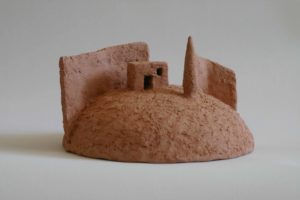
Jonathan Ofek sensually sculpts and draws three-dimensional landscapes in a naive style. His fingerprints are visible in his minimalist clay sculptures, revealing an intimate familiarity with the medium. On every hilltop, mountain, ridge or mound stands a house, a cypress tree, a path, and sometimes a wall crossing the terrain. On the other side of the wall are structures resembling housing projects or multi-story residential buildings.
The works are devised as a series of ´etudes, with each sculpture a variation of the previous one. The landscape details seem archetypal and symbolic—the “house” of all houses, the “cypress” of all cypresses—yet the subtle and varying relationships between the limbs that compose the landscape give the sculptures near-human portrait qualities. Each estate is isolated and comprises a number of recurring features, each with a sculptural element that makes it unique. The landscape appears disjunct and repetitive, like the lyrics of a song’s refrain.
Each image contains a hidden double meaning: the house protects and shelters, but is also a vulnerable ruin that requires its own protection. The towering cypress tree both guards the estate and threatens it. Like an island at sea, the mountain isolates its inhabitants from their surroundings, while the wall bisects the landscape and contains within it the “Other.” The wall is a separation fence, but also the relief of a house, a neighborhood, an urban space, a detail connoting the borders of a space yet containing within it another space.
“Who designed whom?” asks Ofek, and quotes the Hebrew poet Shaul Tchernikovsky: “Man is but an imprint of the landscapes of his homeland.” Did man shape the world or did the world shape man? Does our landscape imbue us with meaning, or vice versa?
The wall that hints at Israel’s divided landscape is also a wall in the broader sense: a wall that separates people, and separates man from himself. For Ofek, there is no difference between internal and external walls. They are both an expression of the same separation.
Avraham Ofek’s art echoes through the works of his son Jonathan. Jonathan manifests influences that are not necessarily breathing down the neck of what is current and fashionable. A traditional medium like clay allows him to express himself at gut-level, at the place where the sculpture is created, on the work table, within arm’s reach.
Jonathan spent some time in Italy as a child and was influenced by the sights, images, architecture and street sculpture of Rome. When asked what made the greatest impression on him, he replied that it was the Four Fountains, and the statue of an obelisk riding an elephant next to the Pantheon—an explicitly figurative statue in dialogue with ancient Roman and Pagan traditions.
It is not surprising, then, than an artist like Mimmo Paladino (of the Transavantgarde movement formed in 1980’s Italy by the art critic and theorist Achille Bonito Oliva) influenced Jonathan with his Neo-Expressionist style, which employs typical traditional form but integrates images that evoke a mysterious, primitive world, a world in which shapes are translated into simple, elegant signs.
Ofek’s landscape sculptures echo the static, massive drawing style of Israel Paldi’s “Eretz Yisrael” works, which reflected a kind of Expressionism saturated with Cubist influences. In his 1928 oil painting, The Road to Safed, Paldi depicts curvaceous mountains, a winding path, and many cypress trees and small houses scattered around. The trees and houses appear to have been duplicated like modular units, and they hint at inhabited estates. The style, na”ive without being saccharine, combined with the rhythmic repetition of stern cypress trees alongside small houses, are reminiscent of Ofek’s sculpted landscapes.
If Italo Calvino, in his journey through invisible cities, had passed through these clay villages planted on platforms of course salt, lifted only slightly off the ground, he might have encountered the single resident of each town. Each such solitary inhabitant has a cypress tree and a wall. Every person born in this miniaturized land is entitled to construct his own town. Sometimes, when the hills are close to one another, the towns are adjacent, but they have constructed walls to maintain their privacy. Sometimes a resident of one such anonymous town might wonder if he is imprisoned, or if, in fact, he is imprisoning the neighboring town.
Mimi Smilan
Curator